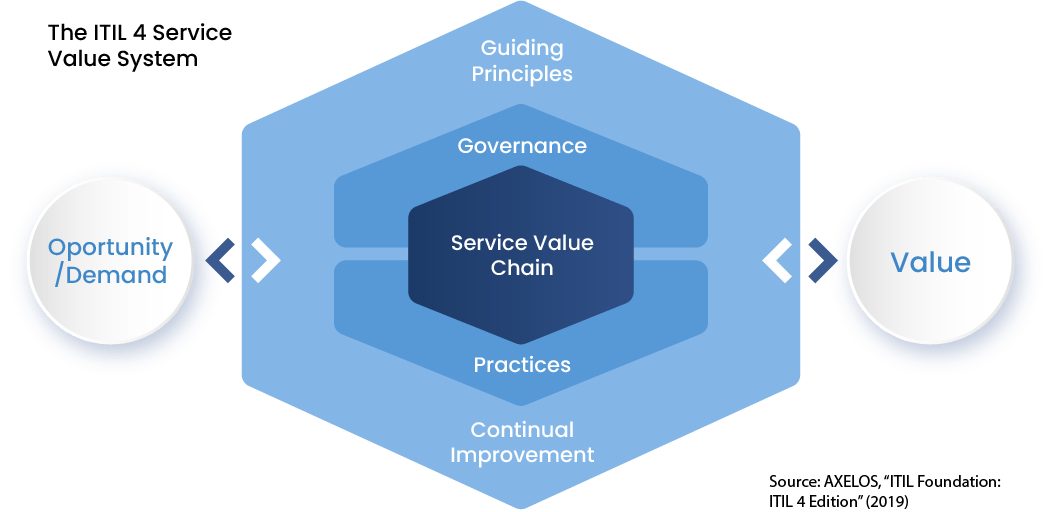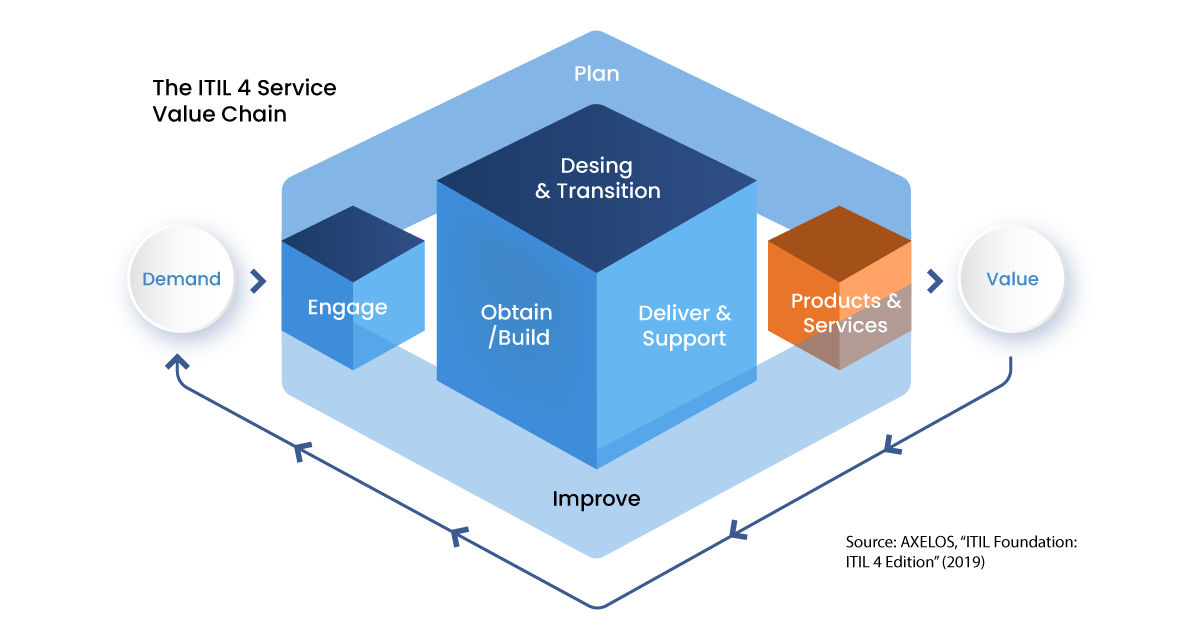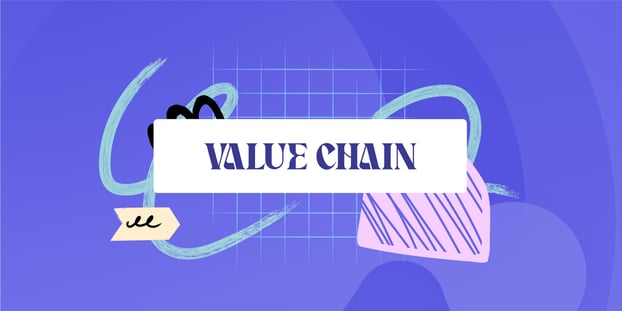The ITIL 4 Foundation Edition introduced the service value chain in 2019, as an operating model to facilitate value realization. We’ve first talked about the topic on our Definitive Guide on ITIL, but it’s time to expand on the concept to understand:
- where it sits within the ITIL service value system,
- what it includes,
- and how it will aid your organization in creating business value via IT services.
So, make sure to keep reading – we’ve thrown some useful examples on how the service value chain works!

What is the service value chain?
The service value chain sits at the heart of the ITIL service value system, which the ITIL 4 Foundation Edition describes as “a model representing how all the components and activities of an organization work together to facilitate value creation.”
In fact, they created a famous diagram showing the ITIL service value system with the service value chain at its center.

But what is exactly the service value chain? In the “ITIL 4 Create, Deliver, and Support” publication, they defined it as:
|
|
“The central element of the service value system is the service value chain, an operating model which outlines the key activities required to respond to demand and facilitate value realization through the creation and management of products and services.” |
This operating model, then, comprises six value chain activities or steps that an organization might take when creating value (we’ll expand on this later on).
As we can see in the infographic below, service value streams start with demand and end with value delivery to the customer.
Nonetheless, it’s important to notice that a value stream created using the service value chain can use any of the primary activities multiple times, and the journey from demand on the left to value on the right (in the service value chain) does not need to be linear. So, a value stream might involve “doubling back” to a previously-passed-through activity.
The IT-related benefits of using the ITIL service value stream for value mapping and value chain analysis are part of the larger benefit set that comes with ITIL use:
- Meeting the business need for “better, faster, cheaper” operations and outcomes for competitive advantage.
- Optimizing IT service delivery and support capabilities and their outcomes.
- Enabling enterprise-wide digital transformation.
Furthermore, the available benefits include:
- A focus on value creation or co-creation (and the ability to demonstrate IT’s worth)
- Standardization and consistency, benefitting from proven best practice
- Better meeting rising customer and employee expectations and demands
- Increased speed and efficiency
- Reduced costs (for competitive advantage)
- Improved control and governance
- A platform for continual improvement
However, given that ITIL 4 relates to service management – not simply IT service management (ITSM) – these benefits can be viewed and realized in non-IT scenarios too.
Value streams and the activity of value stream mapping and value chain analysis are valuable tools for IT organizations (or any other business function) seeking to improve the IT services they deliver. To quote IT service management industry authority Barclay Rae in 2020:
|
|
“I’ve been doing a lot of work with companies on customer journey and value stream mapping. While it’s a leap for some, it’s getting them to ‘play the customer,’ and map internal processes against that. This gives them different perspectives and varied ways to make services work better.” Barclay Rae ITIL 4 CDS lead editor and consultant |
Scope of the ITIL service value chain
The ITIL service value chain applies to every part of IT operations (or those of other business functions). This is because it’s focused on creating business value, and if something doesn’t create value, then why is it being done?
Hence, the service value chain applies to:
- Run the business activities. These activities allow the IT status quo to function (what is commonly called “keeping the lights on”).
- Change the business activities, which includes both growth through innovation and transformation. These direct activities either improve existing services or bring in new ones.
When thinking about the scope of the ITIL service value chain, it’s essential to keep in mind the difference between value streams and processes, pointed out by the “ITIL 4: Create, Deliver, and Support” publication.
In essence, they differentiate in their focuses and how they’re used. “Many sets of interrelated activities that transform inputs into outputs could be considered processes. Value streams are focused around the flow of activity from demand or opportunity to customer value. Process taxonomy and management tools and techniques are therefore applicable to value streams. However, many processes are not value streams.”

The six activities of the service value chain
The service value chain comprises six activities that an organization takes in the creation of value:
- Plan
- Engage
- Design and transition
- Obtain/Build
- Deliver and Support
- Improve
Before we take a closer look at them, it’s relevant to say that all activities are interconnected, and each one of them transforms inputs into outputs; and that these inputs can be either demands from outside the value chain or outputs of other activities.

1. Plan
The Plan value chain activity’s purpose is to ensure a shared understanding of the vision, current status, improvement direction, etc.
Example inputs to the Plan activity are:
- Policies, requirements, and constraint details
- Demands and opportunities from “Engage”
- Third-party service component information from “Engage”
- New and changed products and services information from “Design and transition” and “Obtain/Build”
- Value chain performance and improvement information from “Improve”
Example outputs of the Plan activity are:
- Strategic, tactical, and operational plans
- A product and service portfolio
- Contract and agreement requirements for “Engage”
- Portfolio decisions for “Design and transition”
- Architectures and policies for “Design and transition”
- Continual improvement opportunities
2. Engage
The main objective of the Engage value chain activity is to ensure a good understanding of stakeholder needs, transparency, continual engagement, and good relationships with them. It’s an important primary activity.
Example inputs to the Engage value chain activity are:
- High-level demand data
- Product and service portfolio from “Plan”
- Requirements for services and products from customers
- Contract and agreement requirements
- New and changed products and services information from “Design and transition” and “Obtain/Build”
- Support task and performance information from “Deliver and support”
- Third-party service component information from suppliers and partners (as part of supply chain management)
- Improvement initiatives
Example outputs of the Engage value chain activity are:
- Demand and opportunities for “Plan”
- Requirements for “Design and transition”
- Support tasks for “Deliver and support”
- Change or project requests for “Obtain/Build”
- Contracts and agreements with internal and external suppliers for “Design and transition” and “Obtain/Build”
- Third-party service component information
- Improvement opportunities
- Service performance reports for customers
3. Design and transition
The Design and transition value chain activity’s goal is to ensure that products and services continually meet expectations for quality, costs, and time to market.
Example inputs to the Design and transition value chain activity are:
- Portfolio decisions and architectures and policies from “Plan”
- Product and service requirements, knowledge and information about third-party service components, and contracts and agreements with external and internal suppliers from “Engage”
- Service performance information from “Deliver and support”, and “Improve”
- Service components and new and changed products and services information from “Obtain/Build”
- Improvement initiatives and improvement status reports from “Improve”
Example inputs to the Design and transition value chain activity are:
- Contract and agreement requirements for “Engage”
- Requirements and specifications for “Obtain/Build”
- New and changed products and services for “Deliver and support”
- Performance information and improvement opportunities for “Improve”
- New and changed products and services information to all value chain activities.
4. Obtain/Build
The purpose of the Obtain/Build value chain activity is to ensure service components are available as needed, and meet agreed specifications.
Example inputs to the Obtain/Build value chain activity are:
- Architectures and policies from “Plan”
- Change or project initiation requests from “Engage” and “Deliver and support”
- Third-party service component information and contracts and agreements with external and internal suppliers from “Engage” (as part of supply chain management)
- Requirements and specifications from “Design and transition”
- Improvement initiatives and improvement status reports from “Improve”
- New and changed products and services information from “Design and transition”
Example outputs to the Obtain/Build value chain activity are:
- Contract and agreement requirements for “Engage”
- Service components for “Design and transition”
- Service components for “Deliver and support”
- Performance information and improvement opportunities for “Improve”
- New and changed service component information to all value chain activities
5. Deliver and support
The Deliver and support value chain activity’s purpose is to ensure that service delivery and support are in line with agreed specifications and expectations.
Example inputs to the Deliver and support value chain activity are:
- User support tasks and third-party service component information from “Engage”
- New and changed products and services for “Design and transition”
- New and changed service components and services information from “Design and transition” and “Obtain/Build”
- Service components from “Obtain/Build”
- Improvement initiatives and improvement status reports from “Improve”
Example inputs to the Deliver and support value chain activity are:
- Services delivered to customers and users
- User support task completion information for “Engage”
- Contract and agreement requirements for “Engage”
- Product and service performance information for “Engage” and “Improve”
- Change requests for “Obtain/Build”
- Improvement opportunities for “Improve”
6. Improve
The main goal of the Improve value chain activity is to ensure the continual improvement of products, services, and practices.
Example inputs to the Improve value chain activity are:
- Stakeholders’ feedback and third-party service component information from “Engage”
- New and changed products and services information from “Design and transition” and “Obtain/Build”
- Product and service performance information from “Deliver and support”
- Performance information and improvement opportunities provided by all value chain activities
Example outputs to the Improve value chain activity are:
- Improvement initiatives and improvement status reports for all value chain activities
- Value chain performance information for “Plan”
- Contract and agreement requirements for “Engage”
- Service performance information for “Design and transition”
Service value chain examples
Now, it’s time to see some service value chain examples, with different complexity levels.
Incident management is a good simple example of the service value chain in action. What’s shared below is just one possible value stream, and depending on how your organization wishes to employ its incident management capabilities, this could comprise more or fewer steps.
- Demand – An employee has an issue they need assistance with, so they contact the IT service desk.
- Engage – This is the initial touchpoint between the employee and the IT service desk. It could be a telephone call, or an email, chat, self-service, chatbot, or an in-person approach.
- Deliver and support – The issue is passed to the appropriate resolution group.
- Deliver and support – One or more people within the appropriate resolution group investigate the issue and provide some form of resolution.
- Improve – There might be an opportunity to improve (either “on-the-fly” or retrospectively) where better routes to resolution are considered or any new learning captured. For instance, creating a knowledge article that means similar future issues can be resolved by first-level support.
- Engage – There will likely be some additional engagement with the employee. For instance, checking everything is now working.
- Value – Value is realized because the employee is productive again.
- Engage – A customer satisfaction (CSAT) survey is sent to the employee.
- Improve – Improvements are initiated based on individual or collective customer satisfaction feedback.
- Value – The improvement(s) drive future value.
A more complicated value stream example is the creation of a new IT service:
- Demand – An internal customer has a new need that the IT organization can help with.
- Engage – The internal customer discusses their need with their business relationship manager (or similar IT liaison point).
- Plan – The new service and the possible options are discussed between the involved parties, and the new IT service opportunity is prioritized.
- Plan – The new IT service option costs and risks are assessed.
- Engage – All the information to hand is collectively considered, and a decision is made to continue with the preferred option.
- Plan – The new IT service is added to the service portfolio (as a “pipeline” service to reflect that it is being created).
- Plan – The new IT service project manager and application development personnel plan the required work and resources.
- Engage – More detailed operational requirements (for the first release) are obtained from the customer and other involved parties such as IT support and the IT service desk.
- Obtain/Build – The application development personnel build a backlog, identify the minimum viable product (MVP), and develop sufficient functionality.
- Design and transition/Improve – The initial new IT service build is reviewed, and the backlog is prioritized.
- Obtain/Build - Design and transition – The operational requirements are fully defined.
- Design and transition – The training and documentation are provided to IT support and the IT service desk.
- Obtain/Build - Design and transition – Incremental releases of the new service are created.
- Value – The new IT service is assessed versus the agreed requirements.
- Engage/Deliver and support – Ongoing IT support is provided for the new IT service via the IT service desk.
- Engage/Improve/Value– Regular review meetings are held to assess the new IT service’s performance and identify continual improvement opportunities.
Key takeaways
The service value chain in ITIL 4 is essentially an operating model that lists the six key activities necessary to create value with a product or service – plan, engage, design and transition, obtain/build, deliver and support, and improve.
It can be used to both run the business and change the business activities; and it’s useful for IT and non-IT services. By applying this model, organizations can better meet rising customer and employee expectations and demands, increase speed and efficiency, and reduce costs.
FREE Enterprise Service Management CourseElevate customer satisfaction and optimize organizational performance. |















.jpg?upsize=true&upscale=true&width=780&height=205&name=ITIL%20Foundation%20Exam%20(2).jpg)
